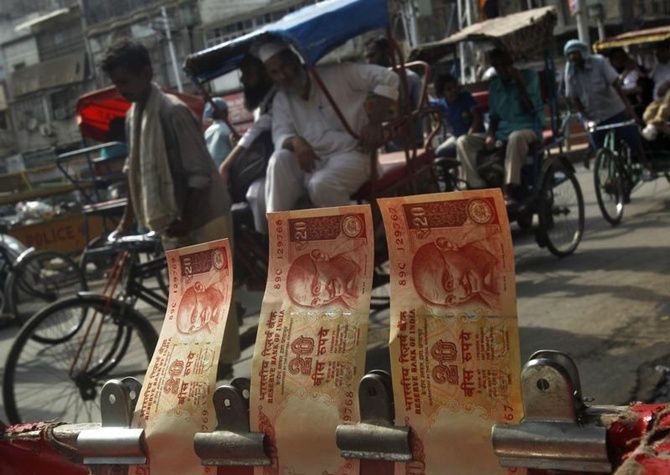An asset swap can simultaneously boost public investment, reduce the fiscal deficit and keep fiscal policy from being pro-cyclical, explains Sajjid Z Chinoy.
 The collapse in global commodity prices - particularly oil - has further reinforced macroeconomic stability in India and cemented India's status as the model child within the emerging market universe.
The collapse in global commodity prices - particularly oil - has further reinforced macroeconomic stability in India and cemented India's status as the model child within the emerging market universe.
But, despite this, growth and private investment remain in a funk, afflicted by overly-leveraged private infrastructure firms, and by risk-averse public sector banks that are weighed down by elevated non-performing assets and who await a significant recapitalization from the government - the fiscal space for which is not apparent.
It is against this backdrop that markets are eagerly awaiting the Budget, hoping that it can simultaneously jumpstart growth while reinforcing macro-economic stability.
Doing so will not be easy, however. In fact, prima facie, the Budget faces three potentially conflicting objectives - an impossible trinity, so to speak.
First, as the government's mid-year economic analysis correctly identified, public investment needs to step up to the plate. Non-defense capex spending of the central government budget averaged two per cent of GDP between 1992 and 2008, but has fallen to just one per cent of GDP the last five years.
Given the woes afflicting private investment, more public investment on infrastructure is sorely needed to boost productivity and gradually crowd-in private investment.
Questions about state capacity will inevitable arise: does the state have the implementation capacity to identify, contract out and monitor a slew of public works projects? But that's where this government will need to show its mettle.
But, more fundamentally, where will the fiscal space for this come from? It is tempting to believe that, in a bid to boost public investment, the medium-term fiscal path for the central government deficit - 3.6 per cent of GDP in FY16 and three per cent in FY17 - should be temporarily abandoned.
But that would be a dangerous approach given the level of India's deficit and debt. India's consolidated fiscal deficit is currently close to 6.5 per cent of GDP, while countries with the same sovereign rating as us have a median and mean deficit of 2.5 per cent of GDP - 400 bps lower!
The inflation tax has been chipping away at India's debt/GDP ratio, but at 65 per cent - it is substantially higher than the 40 per cent debt/GDP ratio of the median country amongst our sovereign ratings peers.
Deviating from the laid out path of fiscal consolidation could raise questions about fiscal credibility and make ratings agencies and foreign investors nervous in a year when the Fed is poised to raise rates and the appetite for emerging market assets may diminish.
What if growth is weak again next year? Will authorities again abandon a new fiscal road-map? This is a slippery slope and in the "rules" versus "discretion" debate, the former has clearly won out in India over the last decade.
But, as if all this is not enough, the third simultaneous challenge, is to ensure that - even as the fiscal is consolidating - it is not generating a negative "fiscal impulse" on the economy, and thereby making fiscal policy pro-cyclical (i.e. tightening the fisc when growth is weak and below potential) - a point again very well articulated by the mid-year economic analysis of the government.
So how does the Budget get around this impossible trinity: higher public investment, yet continued fiscal consolidation and an underlying fiscal stance that is not procyclical?
There is a solution! An asset swap on the public-sector balance sheet, that raises more revenue from asset sales and ploughs those proceeds into infrastructure assets.
The government has a slew of assets on its balance sheet. No one is arguing for privatising all these assets.
But if the government were to gradually reduce its stake across various public sector enterprises, while maintaining a 51 per cent stake, sell its assets within SUTTI - which serve no strategic purpose - continue to sell spectrum, and think creatively by selling/leasing the large quantum of its land holdings, for example, it could mop up a very large quantum of revenue over the next two to three years.
At last count, the value of these assets, even while maintaining a majority stake for the government, was easily above five per cent of GDP.
So what the government needs is a predictable plan - say of 0.8-1 per cent of GDP for the next 2-3 years of asset sales that are directly ploughed into public investment such as highways, roads, bridges, ports, airports - to offset the private sector's inability to finance this infrastructure.
This allows authorities to raise more funds for public investment without busting the fisc.
To be sure, this is not a case of selling the family silver. Instead, viewed more holistically from the public-sector balance sheet, this is simply an asset-swap, from current holdings in PSUs into, arguably, more productive assets that will boost productivity and growth.
This also has benefits from a flow perspective. If incremental fiscal consolidation is achieved largely though incremental asset sales, there is no negative "fiscal impulse" on the real economy.
In most countries of the world, asset sales are "below-the-line" financing items and do not count towards the deficit, because they are not contractionary, like taxes or duties, and are simply an exchange of assets between the public and private sector.
So if next year's fiscal consolidation from 4.1 per cent to 3.6 per cent of GDP is achieved by increasing asset sales by 0.5 per cent of GDP over this year's outturn, the fiscal will not be imparting a negative impulse on the economy, unlike if the consolidation was achieved through higher taxes/duties or lower expenditures.
In other words, the underlying fiscal stance would not really be contractionary, even as the headline deficit is reduced to re-assure investors and ratings agencies that the fiscal goal-posts are not being changed in the middle of the game.
So an asset swap on the public sector balance sheet will allow the government to have its cake and eat it too: boost public investment, stay on the fiscal consolidation path it had agreed to in the July Budget, and yet not impart a negative "fiscal impulse" to an economy when growth is weak.
Of course, the Budget must also do what's less controversial: to compensate for the loss of inflation tax, excise and import duties on oil products must rise, so that these funds can be ear-marked for more infrastructure investment, rather than being passed on to households to be consumed.
Given the oil-subsidies that existed, households never really experienced oil at $120. Why, then, should they get the full benefit when oil is at $50? And the government must better target food and urea subsidies to derive savings on those fronts.
But the key for the Budget is to jumpstart public investment while staying on a path of fiscal consolidation. A judicious use of its balance sheet will allow the government to do both. It must now seize the moment.
The writer is chief India economist, JPMorgan.











